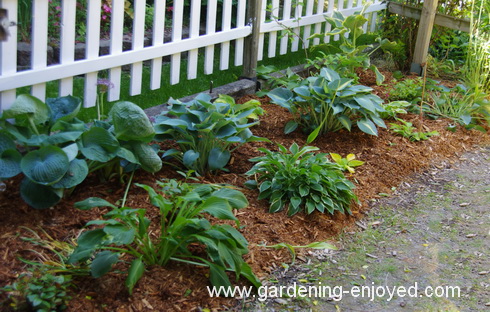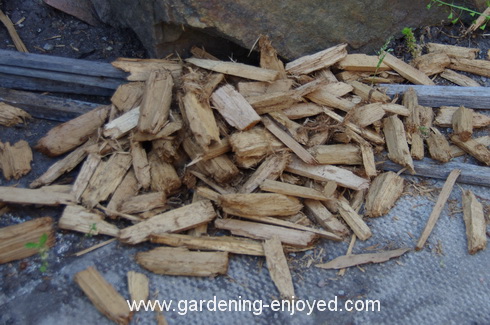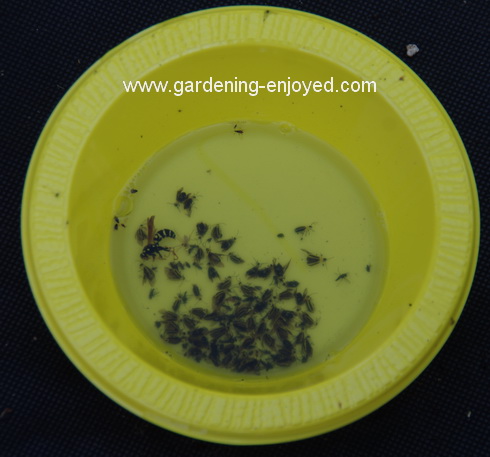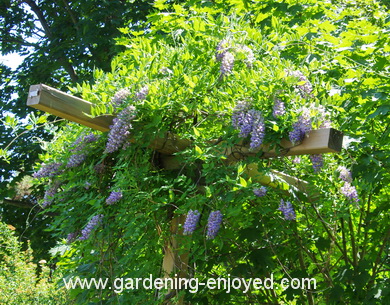
Oso Easy Cherry Pie is one of the first Roses in the Oso Easy group and it has proven its worth here for several years. Tough and resilient are the best descriptors for it. In its background you can see the aluminum siding of the house and it is facing directly south keeping it in the heat and light all day. It is also growing in a narrow gap between the house and an interlocking sidewalk and is surrounded by a mass of groundcover Sedum that competes with it for the bit of rain that might find its way there. I throw a little water or fertilizer on it occasionally, usually what’s left in the watering can after the nearby containers have been watered. It does bloom just like this throughout the summer with some slow periods as one flush of bloom fades. It gets pruned each spring just to maintain its size. The blooms don’t always last very long in the intense heat of its location but more will be along shortly. I really should try some of the newer Oso Easy
varieties.

This space used to grow some wonderful Raspberries but in the last few years they have been quite unsuccessful there. The large Walnut tree to the south has grown and is providing more shade and root competition. I tried a few small flowering shrub samples and a couple of them are still there but most of them were a wonderful winter banquet for the resident rabbits. There are three small Hosta here that I purchased from one of the big box garden centres during their closing sale. All of the rest are transplants from somewhere else in the garden. That’s one of Hosta’s great features. You can dig it up and divide it in the middle of a hot summer’s day and it just picks up and carries on like nothing happened. Some of the softer leaved varieties have wilted a bit but most look like they have been there all along. The daughter up the road was pleased as
well since a piece of each of those Hosta found its way to her new gardens as well. I have overcome my mixed feelings about mulch and used a good depth of plain cedar mulch to try and keep the weeds down and to make the new bed look that much better.

This is why I harbour such mixed feelings about mulch. In almost all types you find a fair quantity of large wood chips. As the finer stuff decomposes you find your garden filled with wood chips that are difficult to work around and will never decompose. Each year as you add more the quantity of wood chips increases. I’ve asked several mulch companies why and why don’t they produce an even textured mulch. I’ve never got a useful answer. This is just one of the small piles I created. I put the bag of mulch in my wheelbarrow to loosen any clumps and fluff it up. I just casually grab the biggest bits as they appear and pitch them into this pile. I could spend half an hour on each bag sorting out all the bits but that seems a touch counter productive. That’s my rant for this week.

Last week I noticed, complained, about the large quantity of Beet leaf borers and now this week I’m plagued by striped Cucumber Beetles. They are attracted to yellow, so a control method is to place a yellow bowl with some soapy water near the plants. This mass of drowned beetles is from two days of that bowl being in the garden. I also go out every morning with my sprayer filled with insecticidal soap and inspect every Cucumber, Squash, Melon and Zucchini and all of them usually have a few of these nasties to knock down. Some mornings they are flying around me such that I can attempt to hit them in flight with my spray, that’s kind of the fun part. The yellow attraction is related to the colour of those plant’s blossoms but most of them haven’t even started to blossom as yet. Despite my best efforts most of the plants are showing some noticeable damage but most also seem to be growing reasonably well. It seems to be a never ending battle with Mother Nature’s less
likeable creatures.

Several years ago I wanted a Wisteria tree. Now we all now that Wisteria is a vine so I built this simple structure to train my vine into a tree-like standard. Here it is blooming wonderfully and encouraging me to finish the project. I need to get out my ladder and drill and create 2 or 3 holes along the length of each of those 4x4 cross pieces. Then the plan is to thread some wire through those holes to create a large flat trellis for the vines to be trained onto. They are growing on each of the cross pieces but I would like a solid 2.5 m canopy of vines for the flowers to trail down from. I started this project in 2015 so apparently there’s no rush to climb up and complete it. Drilling the holes and stringing the wire will probably be a lot easier than untangling that mass of vines and spreading them out. It may be better to do a severe pruning and let the new growth find its way onto the
wires.
To ask a question just “reply” to this ezine. Don’t forget to check the front page of the Website for frequent short ideas for current gardening activities.
Elizabeth Asks? Just reading your Issue 360 where you talk about putting amaryllis out in the summer and feeding them with fertilizer. I have mine out now and wish to know what kind of fertilizer you use. Long ago when Cruickshank's sold amaryllis in Toronto they said to use tomato fertilizer.
Ken Answers! That’s exactly what I use. I don’t keep a variety of fertilizers so almost every container that gets fertilized gets the basic soluble vegetable fertilizer, 18 10 30 is the one I’m currently using. The vegetable garden gets Acti Sol an organic fertilizer of pelleted chicken manure.
Gord Asks? When I transplanted my Green Pepper plants, the next morning one had the leaves cut
off.?? About a week or so has passed, and I went through the garden and loosened up all the soil and weeds.?? Next morning another plant had the leaves cut off and laying on the ground beside it.?? At first I thought it might be a rabbit, but wouldnt a rabbit eat the leaves??? What do you think is my problem.??
Ken Answers!That kind of seemingly senseless damage is often done by Squirrels or Chipmunks and the only real solution is to make little circles of chicken wire around each plant. If you try to fence the whole garden they seem to able to go up and over.
|





